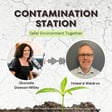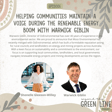
The Benefit of a Structured Change Management Approach with Anna Lundmark
Anna Lundmark is the Director and Principal Consultant at StellaNord Consulting. She is a Certified Site Contamination Specialist under the CEnvP scheme, with 20 years’ experience in contaminated land.
Prior to starting her own business, she was the Manager for Science and Innovation at Hunter Water, Regional Program Manager for Contaminated Land at Hunter JO, and Principal Environmental Consultant at AECOM.
In this episode, Anna discusses the benefit she's seen first hand in adopting a structured approach to change management, through her training in the PROSCI Change Management course.
Anna also shares the Contaminated Land resources on the Hunter Joint Organisation website which are available for free to any council at www.hunterjo.com.au/projects/regional-contaminated-land-program
Thanks so much for listening!
Be sure to rate, review and subscribe to the podcast, and stay tuned for the next episode of Contamination Station: Safer Environment Together.



















